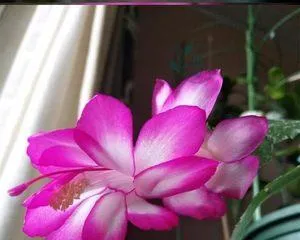The Orchid Cactus is a captivating tropical plant, loved by gardening enthusiasts for its vibrant and uniquely shaped flowers. However, many people encounter difficulties in caring for it and struggle to get it to bloom. This article will introduce you to the methods of caring for the Orchid Cactus, hoping to be of help to you.

1: Choose a suitable care location
Orchid cacti prefer a warm and humid environment and can be placed on a balcony or indoors. However, be careful to avoid direct sunlight and cold drafts, and also ensure good ventilation. If placing it indoors, you can put the orchid cactus by a window or on a north-facing wall.
2: Choose suitable soil
Orchid cacti need soil that is well-aerated and has good drainage. You can mix peat moss and perlite to create the soil, or use a mixture of leaf mold, well-rotted soil, and perlite. At the same time, pay attention to controlling the soil moisture; do not let the soil become too wet.

3: Water moderately
Orchid cacti need to maintain moderate humidity, but they should not be too wet. Generally, watering once or twice a week is sufficient. The specific frequency can be determined based on the temperature and humidity. During the hot summer months, you may need to water more, but be sure to avoid waterlogging.
4: Fertilize moderately
Orchid cacti need a moderate amount of nutrients. You can fertilize them every 1-2 weeks during the growing season. You can use a special orchid fertilizer or a general-purpose fertilizer. However, do not fertilize when the plant is dormant.
5: Control the temperature
The ideal growing temperature for orchid cacti is 18-25°C. It should not exceed 30°C or go below 12°C. If the ambient temperature is too high or too low, it will affect the plant's growth and flowering.

6: Pay attention to pest control
Orchid cacti are susceptible to various pests, such as aphids and termites. You can spray insecticide on the plant or soak the plant in red soil. You can also place some plants like pitcher plants or sunflowers to attract pests away.
7: Prune appropriately
Orchid cacti grow quickly and need appropriate pruning to control their size and shape. You can prune the leaves and flower stalks, but avoid over-pruning.
8: Pay attention to the dormant period
Orchid cacti have a dormant period each year, usually in the autumn and winter. During this time, reduce watering and fertilization appropriately to allow the plant to have sufficient rest.
9: Increase light exposure
Orchid cacti need plenty of light to bloom. In the spring and summer, you can place the plant on a balcony or outdoors to receive more sunlight. However, be careful to avoid overly intense light.
10: Pay attention to irrigation
During the flowering period, orchid cacti need an adequate amount of water, but not too much. You can water it every 2-3 days to ensure the soil remains moist.
11: Avoid exposure to wind and rain
The orchid cactus is relatively fragile during its flowering period and is easily affected by wind and rain. When planting outdoors, choose a suitable location to protect it from wind and rain.
12: Fertilize moderately
During the flowering period, orchid cacti need a moderate amount of nutrients. You can fertilize them every 10 days using either a special orchid fertilizer or a general-purpose fertilizer.
13: Control humidity
During the flowering period, orchid cacti need to maintain appropriate humidity, but it should not be too wet. You can increase air humidity by misting, or place moist perlite or dry ferns at the bottom of the pot.
14: Prune appropriately
During the flowering period, orchid cacti need appropriate pruning. You can prune the flower stalks or pinch off withered flowers. This will promote the growth of new flowers and is also beneficial to the healthy growth of the plant.
15:
The orchid cactus is a beautiful tropical plant. With proper care, it will surely produce gorgeous flowers. We hope this article is helpful to you, allowing you to better care for your orchid cactus.